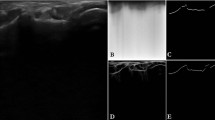Abstract
In the field of computer assisted orthopedic surgery (CAOS) the anterior pelvic plane (APP) is a common concept to determine the pelvic orientation by digitizing distinct pelvic landmarks. As percutaneous palpation is - especially for obese patients - known to be error-prone, B-mode ultrasound (US) imaging could provide an alternative means. Several concepts of using ultrasound imaging to determine the APP landmarks have been introduced. In this paper we present a novel technique, which uses local patch statistical shape models (SSMs) and a hierarchical speed of sound compensation strategy for an accurate determination of the APP. These patches are independently matched and instantiated with respect to associated point clouds derived from the acquired ultrasound images. Potential inaccuracies due to the assumption of a constant speed of sound are compensated by an extended reconstruction scheme. We validated our method with in-vitro studies using a plastic bone covered with a soft-tissue simulation phantom and with a preliminary cadaver trial.
Access this chapter
Tax calculation will be finalised at checkout
Purchases are for personal use only
Preview
Unable to display preview. Download preview PDF.
Similar content being viewed by others
References
Murray, D.: The definition and measurement of acetabular orientation. J. Bone Joint Surg. Br. 75, 228–232 (1993)
McCollum, D., Gray, W.: Dislocation after total hip arthroplasty. Clin. Orthop. Relat. Res. 261, 159–170 (1990)
Lewinnek, G., Lewis, J., et al.: Dislocation after total hip replacement arthroplasties. J. Bone Joint Surg. Am. 60, 217–220 (1978)
Jaramaz, B., Nikou, C., et al.: Effect of cup orientation and neck length in range of motion simulation. Orthop. Res. Soc. 22 (1997)
D’Lima, D., Urquhardt, A., et al.: The effect of the orientation of the acetabular and femoral components on the range of motion of the hip at different head-neck ratios. J. Bone Joint Surg. Am. 82, 315–321 (2000)
Jolles, B., Genoud, P., et al.: Computer-assisted cup placement techniques in total hip arthroplasty improve accuracy of placement. Clin. Orthop. Relat. Res. 426, 174–179 (2004)
Tannast, M., Langlotz, U., et al.: Anatomic referencing of cup orientation in total hip arthroplasty. Clin. Orthop. Relat. Res. 436, 144–150 (2005)
Parratte, S., Kilian, P., et al.: The use of ultrasound in acquisition of the anterior pelvic plane in computer-assisted total hip replacement. J. Bone Joint Surg. Br. 90-B, 258–263 (2008)
Spencer, J., Day, R., et al.: Computer navigation of the acetabular component. J. Bone Joint Surg. Br. 88-B, 972–975 (2006)
Wolf, A., DiGioia, A., et al.: A kinematic model for calculating cup alignment error during total hip arthroplasty. J. Biomech. 38, 2257–2265 (2005)
Tonetti, J., Carrat, L., et al.: Clinical results of percutaneous pelvic surgery. computer-assisted surgery using ultrasound compared to standard fluoroscopy. Comput. Aided Surg. 6, 204–211 (2001)
Dardenne, G., Dusseau, S., et al.: Toward a dynamic approach of tha planning based on ultrasound. Clin. Orthop. Relat. Res. 467, 901–908 (2009)
Chan, C., Barratt, D., et al.: Cadaver validation of the use of ultrasound for 3d model instantiation of bony anatomy in image guided orthopaedic surgery. In: Barillot, C., Haynor, D.R., Hellier, P. (eds.) MICCAI 2004. LNCS, vol. 3217, pp. 397–494. Springer, Heidelberg (2004)
Foroughi, P., Song, D.: Localization of pelvic anatomical coordinate system using us/atlas registration for total hip replacement. In: Metaxas, D., Axel, L., Fichtinger, G., Székely, G. (eds.) MICCAI 2008, Part II. LNCS, vol. 5242, pp. 871–879. Springer, Heidelberg (2008)
Barratt, D., Chan, C., et al.: Instantiation and registration of statistical shape models of the femur and pelvis using 3d ultrasound imaging. Med. Image Anal. 12, 358–374 (2008)
Barratt, D., Penney, G., et al.: Self-calibrating 3d-ultrasound-based bone registration for minimally invasive orthopedic surgery. IEEE Trans. on Med. Imaging 25, 312–323 (2006)
Vercauteren, T., Pennec, X., et al.: Non-parametric diffeomorphic image registration with the demons algorithm. In: Ayache, N., Ourselin, S., Maeder, A. (eds.) MICCAI 2007, Part II. LNCS, vol. 4792, pp. 319–326. Springer, Heidelberg (2007)
Duda, R., Hart, P., Stork, D.: Pattern classification. John Wiley & Sons, Chichester (2000)
Rajamani, K., Styner, M., et al.: Statistical deformable bone models for robust 3d surface extrapolation from sparse data. Med. Image Anal. 11, 99–109 (2007)
Zheng, G., Rajamani, K., et al.: Use of a dense surface point distribution model in a three-stage anatomical shape reconstruction from sparse information for computer assisted orthopaedic surgery: A preliminary study. In: Narayanan, P.J., Nayar, S.K., Shum, H.-Y. (eds.) ACCV 2006. LNCS, vol. 3852, pp. 52–60. Springer, Heidelberg (2006)
Author information
Authors and Affiliations
Editor information
Editors and Affiliations
Rights and permissions
Copyright information
© 2010 Springer-Verlag Berlin Heidelberg
About this paper
Cite this paper
Schumann, S. et al. (2010). Determination of Pelvic Orientation from Ultrasound Images Using Patch-SSMs and a Hierarchical Speed of Sound Compensation Strategy. In: Navab, N., Jannin, P. (eds) Information Processing in Computer-Assisted Interventions. IPCAI 2010. Lecture Notes in Computer Science, vol 6135. Springer, Berlin, Heidelberg. https://doi.org/10.1007/978-3-642-13711-2_15
Download citation
DOI: https://doi.org/10.1007/978-3-642-13711-2_15
Publisher Name: Springer, Berlin, Heidelberg
Print ISBN: 978-3-642-13710-5
Online ISBN: 978-3-642-13711-2
eBook Packages: Computer ScienceComputer Science (R0)




